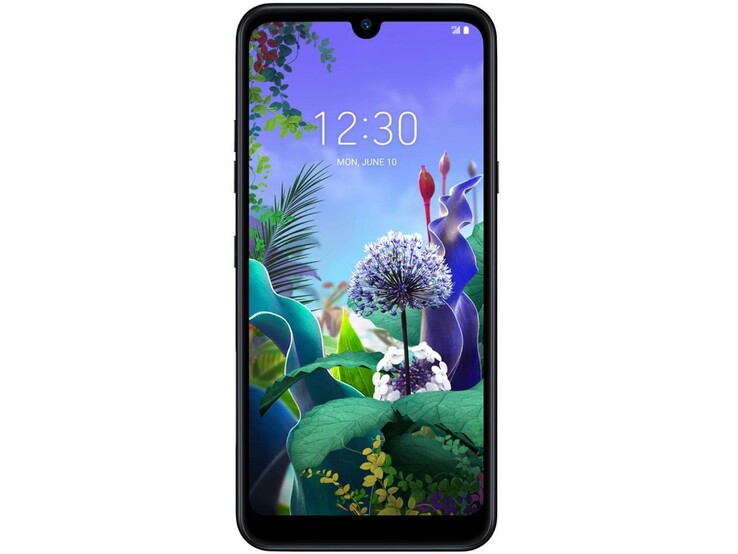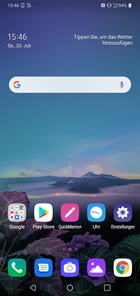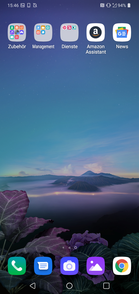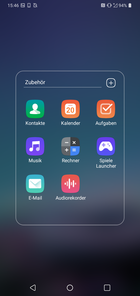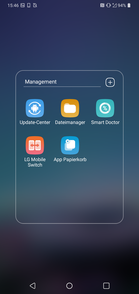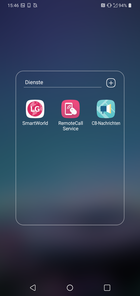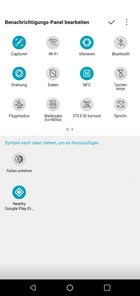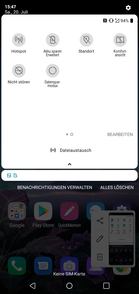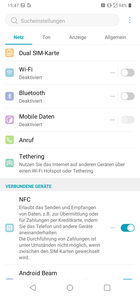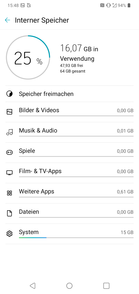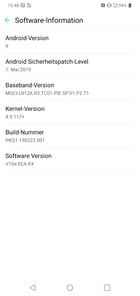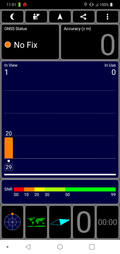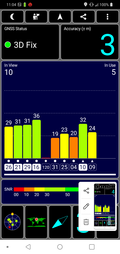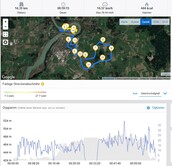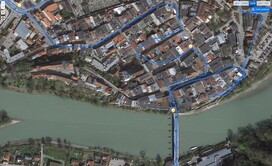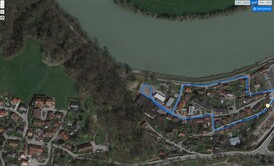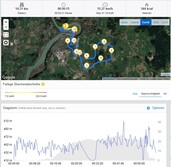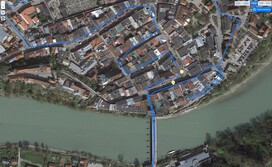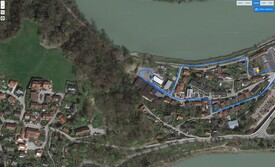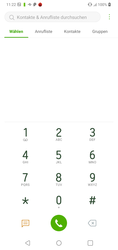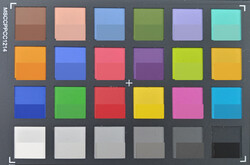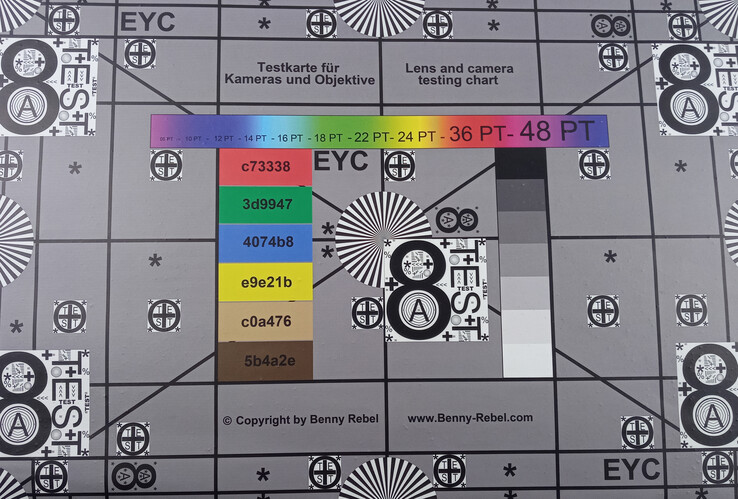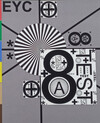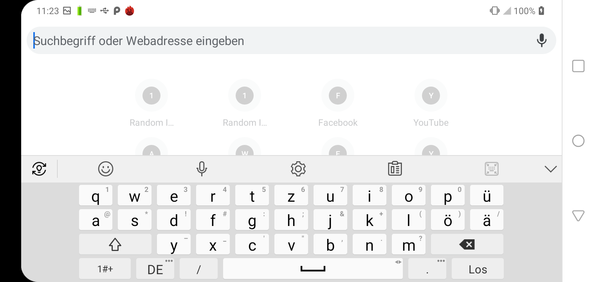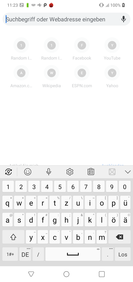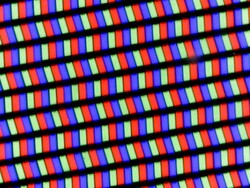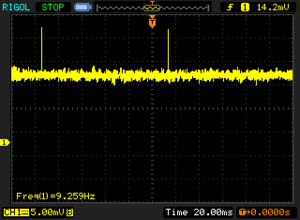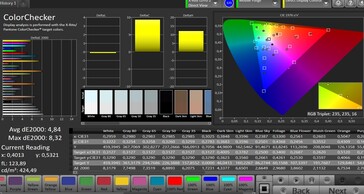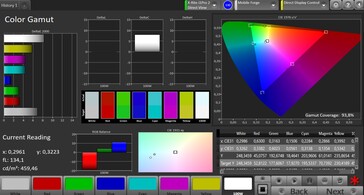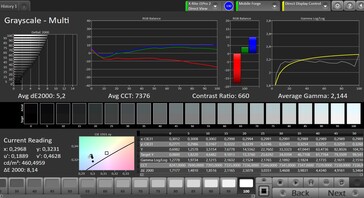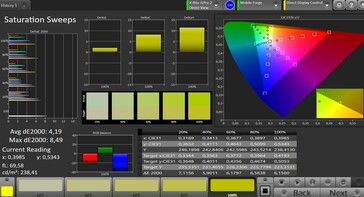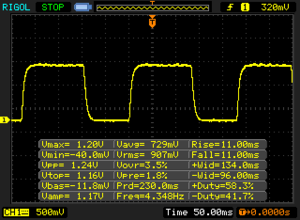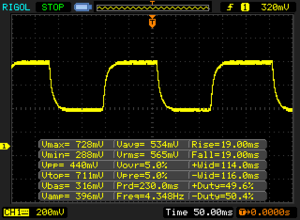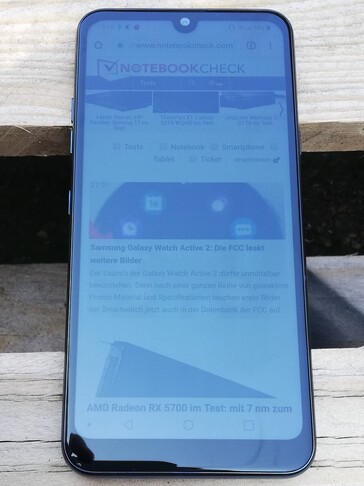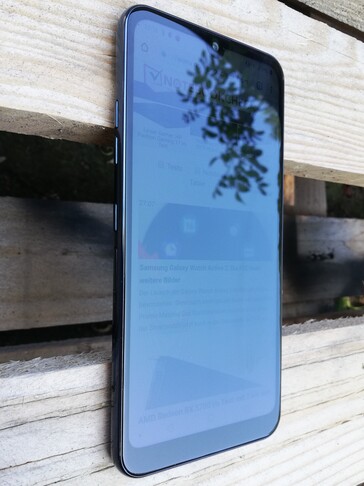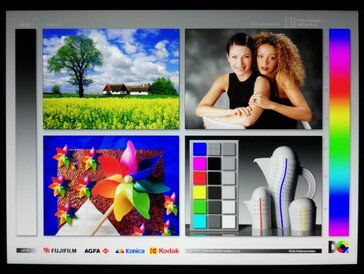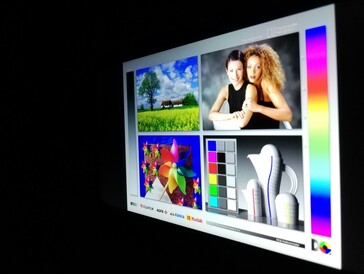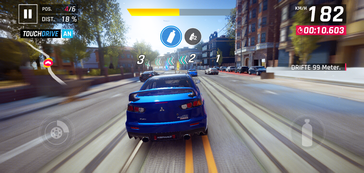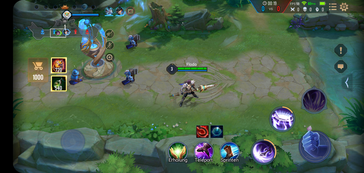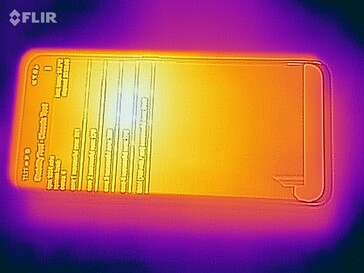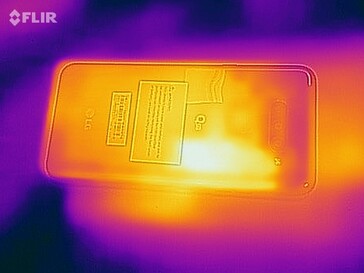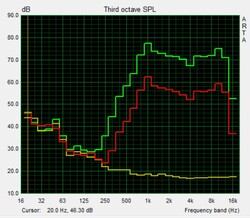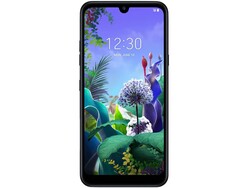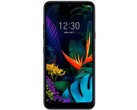LG Q60 Smartphone Review: Triple Camera Smartphone with Assistant Button
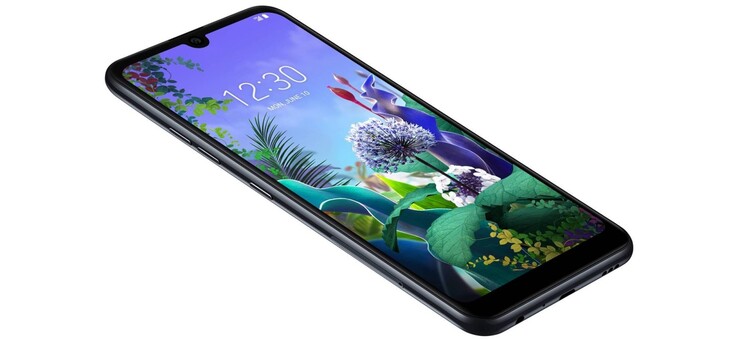
LG often shows positive features with its smartphones in our tests, such as a good battery life in the cheap models K40 and X Power3, but also weaknesses such as a throttling CPU in the high-priced LG G8s ThinQ. Our current test model is the LG Q60 which classifies itself with a price of approximately 250 Euros (~$277) in the middle class segment.
The hardware consists of a Mediatek Helio P22 MT6762, a PowerVR GE8320 graphics unit, 3 GB main memory (RAM) and 64 GB eMMC flash memory. This should provide enough power to run many everyday apps easily. However, the competition in this area is also numerous, which is why we put comparable devices against the Q60.
These include the Xiaomi Redmi Note 7, ZTE's Blade V10, the Samsung Galaxy M20 and Motorola's G7. Under each table you can also add more smartphones from our database for comparison.
Case - LG Q60 brings MIL-STD-810G
The design of the LG Q60 is based on the current trend. Accordingly, there are hardly any surprises. The front is dominated by the screen with a small notch at the top and a slightly wider strip at the bottom, which do not allow for a completely frameless design. The edge of the Android smartphone is made of metal and the back is made of plastic. The main thing that stands out is the arrangement of the physical controls, most of which are on the left side. Only the power button is to be found on the right. All keys are firmly seated in their respective bezels and the NanoSIM / microSD card slot also fits flush with the case. LG promotes the longevity of the Q60 by passing tests according to MIL-STD-810G but does not disclose any specifics.
Compared with the other smartphones in our test field, the LG Q60 is a bit longer, but shows up with a similar width and thickness. In terms of weight, the Android smartphone is with 172 grams (~6.07 oz) in the midfield of our chosen comparison devices.
Equipment - Android Smartphone with NFC
The LG Q60 is powered by a Mediatek Helio P22 MT6762 and 3 GB of memory. There is also a PowerVR GE8320 graphics unit and 64 GB eMMC flash memory. The latter can be expanded with a microSD card by up to 2 TB according to the manufacturer. The DualSIM function is retained because there are separate slots for two NanoSIM cards and one memory card. Both SIM cards can be operated in the LTE network. However, the functions VoLTE and VoWiFi are not available. Since the DRM is limited to Widevine L3, streaming enthusiasts need to dispense with HD content from, for example, Netflix, Amazon Prime or Maxdome. The LG Q60 also has DLNA certification.
Software - Adjustments with LG SmartWorld
The LG Q60 is delivered with Android Pie version 9 and security patches are from May 1st, 2019. The manufacturer makes some adjustments which bring, in addition to the proprietary standard apps, a complete restructuring of the settings menu. After a short familiarization period, however, both Android connoisseurs and newcomers will find their way around well. In addition to various third-party software, such as McAfee Safe Family, LG also installs its own applications, such as LG SmartWorld. With it, users of the Q60 are regularly supplied with background images, ringtones, fonts and much more. This helps with the adjustment of smartphone's individual appearance.
The preinstalled applications can only be disabled in the settings menu, but cannot be uninstalled. Also, applications cannot be moved to the memory card and User Account Control is unavailable.
Communication and GPS - Slow Wi-Fi Disappoints
The LG Q60 can be operated in GSM, 3G and LTE networks. The latter is possible with LTE Cat. 6 which allows download speeds of up to 300 MBit/s and upload rates of up to 50 MBit/s. For local wireless data exchange, NFC, Bluetooth 5.0, as well as WLAN 802.11 a, b, g, n and ac standards are available. Thus, connections can be established not only in the 2.4 GHz band, but also in the faster 5 GHz one.
In our test with the reference router Linksys EA8500, the LG Q60 could only reach very low speeds. Despite the ac standard, the values achieved are only 55.4 Mbps on average for data reception and 53.4 Mbps for data transmission. Thus, the LG smartphone shares the last place in our test field with the Samsung Galaxy M20.
| Networking | |
| iperf3 transmit AX12 | |
| ZTE Blade V10 | |
| Xiaomi Redmi Note 7 | |
| Motorola Moto G7 | |
| LG Q60 | |
| Samsung Galaxy M20 | |
| iperf3 receive AX12 | |
| Xiaomi Redmi Note 7 | |
| ZTE Blade V10 | |
| Motorola Moto G7 | |
| Samsung Galaxy M20 | |
| LG Q60 | |
With the GPS test app we check how well the LG Q60 can determine its location. The Android smartphone has GPS and GLONASS which allow us to achieve an accuracy of about 3 meters (~ 10 ft) outdoors. Indoors, however, it was not possible to perform a position determination.
On our compulsory bike tour we compare the GPS of the LG Q60 with our reference device - the Garmin Edge 520. The recorded route is on long straight lines just slightly beside the actual path; sudden changes of direction can be followed up by the Q60 only in a moderate manner. Slow turns, however, are plotted comparatively well. In everyday use, the LG smartphone is more suitable for simple navigation tasks.
Telephone Functions and Voice Quality - Good Connection with the LG Q60
LG provides users of the Q60 with their own phone app. It allows direct access to a numeric keypad for entering phone numbers. Also available are three more tabs which can be used to view the call list, saved contacts and created groups. In conversations, the LG Q60 offers a good volume and transmits both participants' voices clearly. Noise filtering functions relatively well, which make conversations possible even in louder environments.
Cameras - Triple Camera with Pale Colors
The LG Q60 is equipped with a triple camera on the back. It features a 16 MP f/2.0 aperture sensor, a 5 MP sensor with f/2.2 aperture and wide angle, as well as a 2 MP sensor with f/2.4 aperture. On the front there is also a 13 MP camera with f/2.0 aperture. This allows for portraits with a comparatively good quality, whereby the selected subject is clearly visible. However, colors seem a bit pale and light areas are slightly overexposed. In addition to various color filters, users can also enable a beautify mode that softens skin, for example. A manual mode for adjusting individual values is not available for the front camera. The "Flash Jump-Cut" mode, however, can merge multiple recordings into a GIF, and with "YouTube Live" users can stream directly to their YouTube channel. The "QLens" function can also display information and purchase suggestions for photographed objects.
The main camera captures panoramic subjects well, while the colors look a bit pale. Objects edges are already slightly blurred at low zoom levels and poor lighting conditions have a negative effect on the result. Even at close range, colors look a bit pale and blurred object edges stand out even more clearly. Areas with similar colors are also a bit mushy. Although the Q60's camera captures our test subject to a large extent and darkens only the upper corners, object edges are very blurred and surfaces washed out. In addition to the options above, users can still change the quality of the main camera through a food- photography mode and a wide-angle mode. A switchable AI also selects the best settings for the selected subject. The main camera does not even have a manual mode or similar.
Videos taken with the camera of the LG Q60 have a similar quality, as shown in our test photos. Brightness differences are adjusted with a small delay and minor shakes are compensated by an image stabilizer. The resolutions which can be selected in the Settings menu are "FHD 16:9 1,920x1,080", "HD 18.9:9 1,512x720", and "HD 16:9 1280x720". A high-frame-rate mode or the like is not available.
With the ColorChecker Passport we check how well the camera of the Q60 can reproduce colors. It turns out that colors are consistently absorbed brighter than they should be according to our template. This also applies to dark grey and black tones.
Under controlled light conditions, the camera of the LG smartphone reproduces our test chart in detail. Fine structures and details are easily recognizable, but colors are very pale here as well. In addition, a clear paleness can be observed in the upper left corners.
Accessories and Warranty - LG Q60 with MicroUSB Cable
The LG Q60 comes with a USB power adapter with matching MicroUSB cable and a SIM needle to open the SIM/microSD card slot. Other accessories, specifically tailored to the Q60, are not offered by LG. Via the manufacturer's website, however, one can buy high-quality headsets for smartphones, for example.
LG offers a warranty period of 24 months to the buyers of the Q60. Further information can be found in our FAQ on "Guarantee, Warranty, Return Policy".
Input Devices and Handling - Android Smartphone with Assistant Button
For the input of texts LG provides the users of the Q60 with its own keyboard app. It is well suited for entering longer sentences and can be adjusted in many ways. For example, the keyboard height and layout can be set and one-hand operation activated. Swipe inputs, such as SwiftKey, are not supported.
The touch screen of the Q60 responds reliably to touch and transmits it directly to the system. The smooth screen surface is also suitable for longer drag-and-drop movements. In addition to the usual volume controls and on/off controls on the side of the device, the LG Q60 has an additional button that activates the Google Assistant when pressed once. Pressing the button twice will open not only the Assistant, but also upcoming appointments and existing notes. The "special" LG voice commands refer to features such as calendar entries and opening messages, which in principle can also be provided by the Google Assistant.
There is also a fingerprint sensor on the back of the LG Q60. It quickly detects stored fingerprints and reliably unlocks the system. The position sensor also reacts quickly to movements of the smartphone and adjusts the image content according to the orientation of the phone.
Display - 6-Inch Smartphone with Bright Display
The screen of the LG Q60 consists of a 6.26-inch IPS panel with a resolution of 1,520 x 720 pixels. The average brightness of 437 cd/m² is below the other devices in our test field, but it is by no means bad. When the sensor is activated we measure a maximum brightness of 477 cd/m² and in the APL50 test a maximum of 450 cd/m² is achieved.
Our measurements also show that the screen flickers at a brightness level below 20 percent with a frequency of 9,259 Hz. Since this value is comparatively high and also occurs only at low brightness levels, even users with sensitive eyes should not have any problems using the LG Q60.
| |||||||||||||||||||||||||
Brightness Distribution: 87 %
Center on Battery: 477 cd/m²
Contrast: 681:1 (Black: 0.7 cd/m²)
ΔE ColorChecker Calman: 4.84 | ∀{0.5-29.43 Ø4.77}
ΔE Greyscale Calman: 5.2 | ∀{0.09-98 Ø5}
93.8% sRGB (Calman 2D)
Gamma: 2.144
CCT: 7376 K
| LG Q60 IPS, 1520x720, 6.3" | Motorola Moto G7 IPS, 2270x1080, 6.2" | Xiaomi Redmi Note 7 IPS, 2340x1080, 6.3" | Samsung Galaxy M20 PLS TFT, 2340x1080, 6.3" | ZTE Blade V10 IPS, 2280x1080, 6.3" | |
|---|---|---|---|---|---|
| Screen | 9% | 46% | 6% | -14% | |
| Brightness middle (cd/m²) | 477 | 471 -1% | 541 13% | 452 -5% | 492 3% |
| Brightness (cd/m²) | 437 | 453 4% | 540 24% | 445 2% | 485 11% |
| Brightness Distribution (%) | 87 | 94 8% | 91 5% | 92 6% | 93 7% |
| Black Level * (cd/m²) | 0.7 | 0.5 29% | 0.33 53% | 0.41 41% | 0.32 54% |
| Contrast (:1) | 681 | 942 38% | 1639 141% | 1102 62% | 1538 126% |
| Colorchecker dE 2000 * | 4.84 | 5.5 -14% | 2.7 44% | 5.3 -10% | 8.6 -78% |
| Colorchecker dE 2000 max. * | 8.32 | 7.95 4% | 4.6 45% | 9.5 -14% | 17.1 -106% |
| Greyscale dE 2000 * | 5.2 | 5 4% | 3.1 40% | 6.8 -31% | 11.8 -127% |
| Gamma | 2.144 103% | 2.326 95% | 2.26 97% | 2.23 99% | 2.14 103% |
| CCT | 7376 88% | 7654 85% | 6853 95% | 8355 78% | 10458 62% |
* ... smaller is better
Screen Flickering / PWM (Pulse-Width Modulation)
| Screen flickering / PWM detected | 9259 Hz | ≤ 20 % brightness setting | |
The display backlight flickers at 9259 Hz (worst case, e.g., utilizing PWM) Flickering detected at a brightness setting of 20 % and below. There should be no flickering or PWM above this brightness setting. The frequency of 9259 Hz is quite high, so most users sensitive to PWM should not notice any flickering. In comparison: 53 % of all tested devices do not use PWM to dim the display. If PWM was detected, an average of 8084 (minimum: 5 - maximum: 343500) Hz was measured. | |||
The screen of the LG Q60 shows a relatively low contrast ratio of 681:1 and a significantly increased black level of 0.7 cd/m². As a result, colors are not very well demarcated from one another and black image contents look as if they were covered in a light gray haze. In the APL50 test, the black value is somewhat lower at 0.63 cd/m². Again, the LG Q60 has to settle for last place in our test field.
The CalMAN analysis shows that colors are displayed on the Q60 with a reduced red and a slightly increased blue content. Users can only influence the color representation by activating comfort view. This places a yellow veil over the image, whose intensity can be determined on a freely adjustable scale.
Display Response Times
| ↔ Response Time Black to White | ||
|---|---|---|
| 22 ms ... rise ↗ and fall ↘ combined | ↗ 11 ms rise | |
| ↘ 11 ms fall | ||
| The screen shows good response rates in our tests, but may be too slow for competitive gamers. In comparison, all tested devices range from 0.1 (minimum) to 240 (maximum) ms. » 47 % of all devices are better. This means that the measured response time is similar to the average of all tested devices (20.2 ms). | ||
| ↔ Response Time 50% Grey to 80% Grey | ||
| 38 ms ... rise ↗ and fall ↘ combined | ↗ 19 ms rise | |
| ↘ 19 ms fall | ||
| The screen shows slow response rates in our tests and will be unsatisfactory for gamers. In comparison, all tested devices range from 0.165 (minimum) to 636 (maximum) ms. » 54 % of all devices are better. This means that the measured response time is worse than the average of all tested devices (31.6 ms). | ||
The LG Q60 can easily be used outdoors, as long as shady places are preferred. The brightness is sufficient to make picture content easy to read. Reflections or reflections of objects in the environment are less pronounced than, for example, with the ZTE Blade V10. In direct sunlight however, it is still difficult to read content from the screen.
The IPS panel of the LG Q60 has very stable viewing angles. Image content can be read from almost any angle without being distorted or reproduced with distorted colors. Unless reflections or reflections from surrounding objects obstruct the view, the Q60 can also be used from rather unusual positions.
Performance - LG Q60 Offers Middle Class Performance
The LG Q60 features Mediatek's Helio P22 MT6762 and a PowerVR GE8320 graphics unit with typical mid-range features. Additionally, the smartphone is equipped with 3 GB of RAM and a 64 GB eMMC flash memory. Thus, most everyday apps can be run and there are small reserves available for more sophisticated programs. The memory is really meager compared to the competition.
In our benchmark tests, the LG Q60 achieves a below-average result. The performance offered is not quite what we know from other smartphones with Mediatek Helio P22 MT6762. In comparison with the other devices in our test field, it is therefore only enough for the last place.
| PCMark for Android | |
| Work performance score (sort by value) | |
| LG Q60 | |
| Motorola Moto G7 | |
| Xiaomi Redmi Note 7 | |
| Samsung Galaxy M20 | |
| ZTE Blade V10 | |
| Average Mediatek Helio P22 MT6762 (4404 - 7465, n=18) | |
| Work 2.0 performance score (sort by value) | |
| LG Q60 | |
| Motorola Moto G7 | |
| Xiaomi Redmi Note 7 | |
| Samsung Galaxy M20 | |
| ZTE Blade V10 | |
| Average Mediatek Helio P22 MT6762 (3805 - 5380, n=21) | |
| GFXBench 3.1 | |
| on screen Manhattan ES 3.1 Onscreen (sort by value) | |
| LG Q60 | |
| Motorola Moto G7 | |
| Xiaomi Redmi Note 7 | |
| Samsung Galaxy M20 | |
| ZTE Blade V10 | |
| Average Mediatek Helio P22 MT6762 (10 - 11, n=9) | |
| Average of class Smartphone (11 - 166, n=155, last 2 years) | |
| 1920x1080 Manhattan ES 3.1 Offscreen (sort by value) | |
| LG Q60 | |
| Motorola Moto G7 | |
| Xiaomi Redmi Note 7 | |
| Samsung Galaxy M20 | |
| ZTE Blade V10 | |
| Average Mediatek Helio P22 MT6762 (3.7 - 6.2, n=9) | |
| Average of class Smartphone (8.4 - 413, n=154, last 2 years) | |
| AnTuTu v7 - Total Score (sort by value) | |
| LG Q60 | |
| Motorola Moto G7 | |
| Xiaomi Redmi Note 7 | |
| Samsung Galaxy M20 | |
| ZTE Blade V10 | |
| Average Mediatek Helio P22 MT6762 (71347 - 88242, n=9) | |
In the browser benchmarks, the slight underperformance of the LG Q60 continues. Again, the results are just good enough for the last place in our test field. In everyday life, however, the browser offers smooth scrolling when visiting web pages and media contents are loaded promptly.
| JetStream 1.1 - Total Score | |
| Xiaomi Redmi Note 7 (Chrome 72) | |
| ZTE Blade V10 (Chrome 74) | |
| Motorola Moto G7 (Chrome 71) | |
| Samsung Galaxy M20 (Samsung Browser 9.2) | |
| Average Mediatek Helio P22 MT6762 (22.7 - 24.6, n=5) | |
| LG Q60 (Chrome 75) | |
| WebXPRT 3 - Overall | |
| Average of class Smartphone (38 - 380, n=30, last 2 years) | |
| Xiaomi Redmi Note 7 (Chrome 72) | |
| Motorola Moto G7 (Chrome 71) | |
| Samsung Galaxy M20 | |
| ZTE Blade V10 (Chrome 74) | |
| LG Q60 (Chrome 75) | |
| Average Mediatek Helio P22 MT6762 (26 - 30, n=7) | |
| Octane V2 - Total Score | |
| Average of class Smartphone (2228 - 126661, n=194, last 2 years) | |
| Xiaomi Redmi Note 7 (Chrome 72) | |
| ZTE Blade V10 (Chrome 74) | |
| Samsung Galaxy M20 | |
| Motorola Moto G7 (Chrome 71) | |
| LG Q60 (Chrome 75) | |
| Average Mediatek Helio P22 MT6762 (3312 - 4508, n=9) | |
| Mozilla Kraken 1.1 - Total | |
| LG Q60 (Chrome 75) | |
| Average Mediatek Helio P22 MT6762 (10846 - 12799, n=9) | |
| Motorola Moto G7 (Chrome 71) | |
| ZTE Blade V10 (Chrome 74) | |
| Xiaomi Redmi Note 7 (Chrome 72) | |
| Samsung Galaxy M20 | |
| Average of class Smartphone (257 - 28190, n=154, last 2 years) | |
* ... smaller is better
LG Q60 users have access to a 64 GB eMMC flash memory, approximately 55 GB of which can be used to store their own data and install apps. Although the write and read rates in our test are not so slow to affect the system operation, they are still low compared to the competition.
The LG smartphone provides a microSD card reader for memory expansion, which can accommodate memory cards of up to 2 TB in size according to the manufacturer. With our reference memory card Toshiba Exceria Pro M501, the Q60 achieves data transfer rates that are only slightly below the level of other smartphones in our test field.
| LG Q60 | Motorola Moto G7 | Xiaomi Redmi Note 7 | Samsung Galaxy M20 | ZTE Blade V10 | Global Average -3 | Average of class Smartphone | ||
|---|---|---|---|---|---|---|---|---|
| AndroBench 3-5 | 105% | 32% | 50% | 32% | 242% | 1341% | ||
| Sequential Read 256KB (MB/s) | 266.2 | 297 12% | 283.4 6% | 300 13% | 295 11% | 777 ? 192% | 2235 ? 740% | |
| Sequential Write 256KB (MB/s) | 97.9 | 216 121% | 204.7 109% | 137 40% | 200.7 105% | 502 ? 413% | 1871 ? 1811% | |
| Random Read 4KB (MB/s) | 53.9 | 69.3 29% | 82.9 54% | 64 19% | 82.7 53% | 123.3 ? 129% | 297 ? 451% | |
| Random Write 4KB (MB/s) | 13.94 | 75.6 442% | 16.06 15% | 44 216% | 16.79 20% | 117.3 ? 741% | 343 ? 2361% | |
| Sequential Read 256KB SDCard (MB/s) | 79.5 ? | 86.9 ? 9% | 83.2 ? 5% | 81.5 ? 3% | 77.2 ? -3% | 69.8 ? -12% | ||
| Sequential Write 256KB SDCard (MB/s) | 58.7 ? | 66.8 ? 14% | 59.5 ? 1% | 65.3 ? 11% | 61 ? 4% | 51.7 ? -12% |
Games - LG Smartphone Suitable For Gaming
The PowerVR GE8320 in the LG Q60 can easily run most modern games at medium graphics settings. The performance depends heavily on the chosen title and its demands on the GPU. For example, the "Arena of Valor" game we tested ran smoothly at high graphics levels and HD enabled, whereas the more sophisticated "Asphalt 9: Legends" showed noticeable stuttering already with default settings. The operation via the touch screen was easily possible and also the position sensor transmitted movements of the smartphone reliably into the game.
Emissions - Speakers for Occasional Usage
Temperature
According to our measurements, the LG Q60 surface temperatures reach up to 34 °C (93.2 °F) at idle and a maximum of 38.8 °C (101.84 °F) under load. Although the smartphone feels quite warm, it never gets too hot to hold it in your hand, for example. During our test period we did not notice any restrictions that could be attributed to high inside temperatures.
(+) The maximum temperature on the upper side is 38.8 °C / 102 F, compared to the average of 35.2 °C / 95 F, ranging from 21.9 to 247 °C for the class Smartphone.
(+) The bottom heats up to a maximum of 38.3 °C / 101 F, compared to the average of 34 °C / 93 F
(±) In idle usage, the average temperature for the upper side is 32 °C / 90 F, compared to the device average of 32.9 °C / 91 F.
Speakers
The speaker of the LG Q60 offers good volume and a relatively balanced sound spectrum. However, tones below the mids fall sharply and the heights are slightly underrepresented. The LG smartphone is therefore quite suitable for the occasional playback of media content. For regular use, however, users should prefer headphones or external speakers. In addition to Bluetooth 5.0, these can also be connected to the Q60 via the existing 3.5 mm jack connection. Connected audio devices can be controlled with DTS:X 3D Surround Sound.
LG Q60 audio analysis
(+) | speakers can play relatively loud (84 dB)
Bass 100 - 315 Hz
(-) | nearly no bass - on average 70.4% lower than median
(+) | bass is linear (0% delta to prev. frequency)
Mids 400 - 2000 Hz
(-) | nearly no mids - on average 70.4% lower than median
(+) | mids are linear (0% delta to prev. frequency)
Highs 2 - 16 kHz
(-) | nearly no highs - on average 70.4% lower than median
(+) | highs are linear (0% delta to prev. frequency)
Overall 100 - 16.000 Hz
(-) | overall sound is not linear (120.8% difference to median)
Compared to same class
» 89% of all tested devices in this class were better, 8% similar, 2% worse
» The best had a delta of 11%, average was 35%, worst was 134%
Compared to all devices tested
» 97% of all tested devices were better, 3% similar, 1% worse
» The best had a delta of 4%, average was 24%, worst was 134%
Xiaomi Redmi Note 7 audio analysis
(+) | speakers can play relatively loud (87.6 dB)
Bass 100 - 315 Hz
(-) | nearly no bass - on average 27.6% lower than median
(±) | linearity of bass is average (12% delta to prev. frequency)
Mids 400 - 2000 Hz
(+) | balanced mids - only 4.1% away from median
(+) | mids are linear (4.5% delta to prev. frequency)
Highs 2 - 16 kHz
(±) | higher highs - on average 5% higher than median
(+) | highs are linear (4.9% delta to prev. frequency)
Overall 100 - 16.000 Hz
(±) | linearity of overall sound is average (19.3% difference to median)
Compared to same class
» 26% of all tested devices in this class were better, 9% similar, 65% worse
» The best had a delta of 11%, average was 35%, worst was 134%
Compared to all devices tested
» 46% of all tested devices were better, 8% similar, 46% worse
» The best had a delta of 4%, average was 24%, worst was 134%
Battery Life - Sparing Android Smartphone
Power Consumption
According to our measurements, the LG Q60 has a power consumption of at least 0.8 watts when idle and up to 5.9 watts under load. On average, the Android smartphone is among the more sparing devices in our test field. Only the ZTE Blade V10 has a lower energy requirement.
The supplied charger has an output power of 6 watts and is therefore sufficient to supply the LG Q60 with enough energy.
| Off / Standby | |
| Idle | |
| Load |
|
Key:
min: | |
| LG Q60 3500 mAh | Motorola Moto G7 3000 mAh | Xiaomi Redmi Note 7 4000 mAh | Samsung Galaxy M20 5000 mAh | ZTE Blade V10 3200 mAh | Average Mediatek Helio P22 MT6762 | Average of class Smartphone | |
|---|---|---|---|---|---|---|---|
| Power Consumption | -23% | -17% | -18% | 8% | 13% | -31% | |
| Idle Minimum * (Watt) | 0.8 | 1.1 -38% | 0.61 24% | 0.94 -18% | 0.61 24% | 0.669 ? 16% | 0.847 ? -6% |
| Idle Average * (Watt) | 1.3 | 1.8 -38% | 1.95 -50% | 2.37 -82% | 1.7 -31% | 1.577 ? -21% | 1.448 ? -11% |
| Idle Maximum * (Watt) | 2.2 | 2.6 -18% | 2.03 8% | 2.42 -10% | 1.73 21% | 1.851 ? 16% | 1.633 ? 26% |
| Load Average * (Watt) | 4 | 4.2 -5% | 4.56 -14% | 3.83 4% | 3.24 19% | 2.91 ? 27% | 6.96 ? -74% |
| Load Maximum * (Watt) | 5.9 | 6.8 -15% | 9.15 -55% | 5.07 14% | 5.63 5% | 4.41 ? 25% | 11.3 ? -92% |
* ... smaller is better
Battery Life
In our practical Wi-Fi test, the LG Q60 achieves a run time of almost 16 hours. Thus, it lasts much longer than comparable smartphones in our test field and exceeds, for example, the Xiaomi Redmi Note 7 with its larger battery significantly.
The included AC adapter can fully charge the 3500 mAh battery in about three hours.
| LG Q60 3500 mAh | Motorola Moto G7 3000 mAh | Xiaomi Redmi Note 7 4000 mAh | Samsung Galaxy M20 5000 mAh | ZTE Blade V10 3200 mAh | |
|---|---|---|---|---|---|
| Battery runtime | |||||
| WiFi v1.3 (h) | 15.8 | 13.3 -16% | 12.8 -19% | 15.5 -2% | 11.1 -30% |
Pros
Cons
Verdict - Simple Middle Class with Additional Button
LG delivers with the Q60 a smartphone in the middle class whose performance in the benchmarks falls behind the competition. The sparing memory and the moderate camera performance make the Q60 look not very good at first glance, and the added value of a Google Assistant key should not be very big. Seen in detail however, LG performs a lot better than the competition.
The LG Q60 does not quite meet our expectations for its performance, but convinces with a good craftsmanship.
The smartphone is of a very high quality and the smooth touch screen ensures pleasant drag-and-drop movements. Also, the screen surface does not reflect as much as other smartphones in this class. Battery life is also very good, which is generally one of the most important features of a smartphone for users. However, what remains is the adapted Android system whose advantages and disadvantages are in the end decided by the taste of the user.
LG Q60
- 07/29/2019 v6 (old)
Mike Wobker




